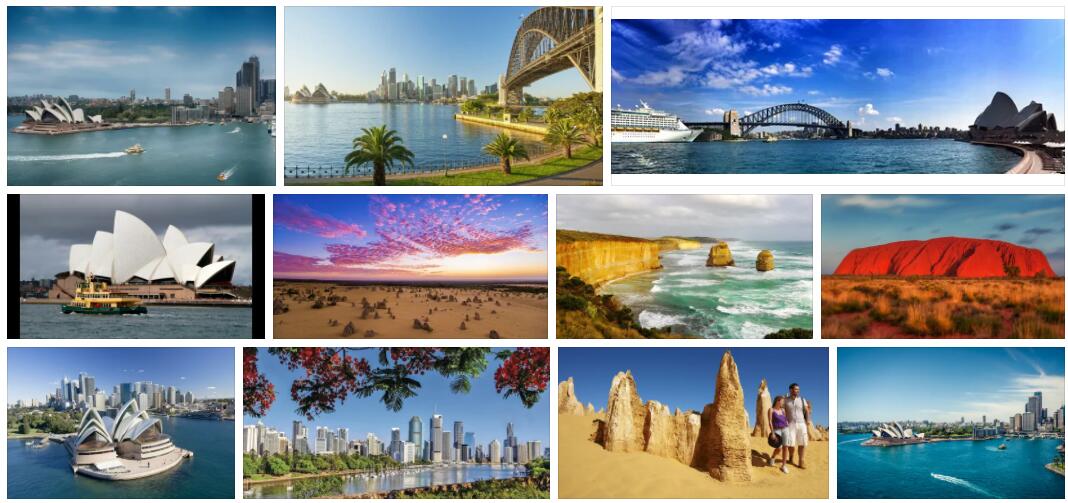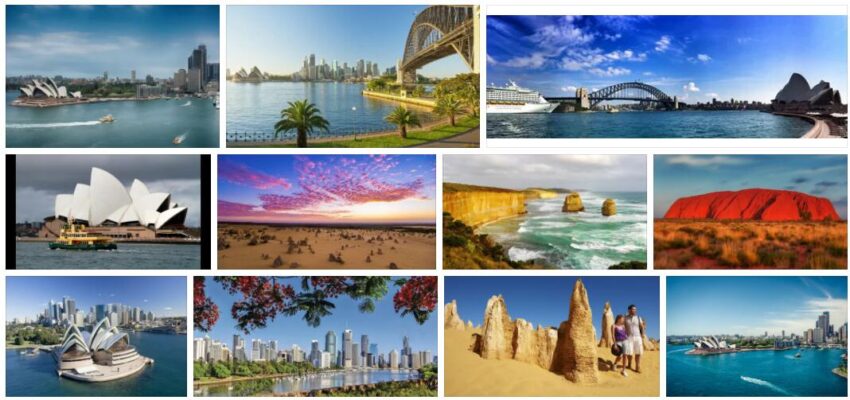Oceania’s many islands are divided into three main groups according to their plate tectonic formation. The first group includes some of the largest islands such as New Zealand and New Caledonia. They lie in the collision zone between the Indo-Australian Plate and the Pacific Plate and consist of younger rocks formed during the alpine fold. The islands contain fragments of continental plates and intertwined volcanic arches. They are characterized by mountain ranges with highly folded and metamorphosed rocks, and considerable volcanism occurs.
The second group consists of young volcanic arches formed over active subduction zones, where one ocean floor plate is submerged below another. An example of this is the archipelago of the Mariana Islands, formed where the Pacific Plate is brought under the Philippine Plate.
The third group is made up of a large number of smaller islands, especially on the inner part of the Pacific plate. These islands are primarily caused by underwater volcanism, caused by hot spots, i.e. point-rising heat flows from the jacket. If volcanism ceases, a gradual subsidence occurs. As the ocean floor plate moves across a prolonged hot spot, the active volcanic islands will therefore have a long line of extinct and “drowned” volcanic islands after them, such as the archipelago of Hawaii. In the subtropical and tropical parts of the Pacific, strong coral growth can occur at the same rate as the subsidence, forming coral islands and atolls over the drowning volcanic islands. At higher latitudes, the islands turn into undersea mountains and plateaus.
See airports of Australia and New Zealand on Countryaah.
| Country | Proportion of women (percent) | Fertility rate (number of children born per woman) |
| Australia | 50.2 (2017) | 1.8 (2016) |
| Fiji | 49.2 (2017) | 2.5 (2016) |
| Kiribati | 50.7 (2017) | 3.7 (2016) |
| Marshall Islands | – | 4.1 (2011) |
| Micronesia Federation | 48.7 (2017) | 3.1 (2016) |
| Nauru | – | – |
| New Zealand | 50.8 (2017) | 1.9 (2016) |
| Palau | – | 2.2 (2015) |
| Papua New Guinea | 49.1 (2017) | 3.7 (2016) |
| Solomon Islands | 49.2 (2017) | 3.9 (2016) |
| Samoa | 48.4 (2017) | 4.0 (2016) |
| Tonga | 49.8 (2017) | 3.6 (2016) |
| Tuvalu | – | – |
| Vanuatu | 49.4 (2017) | 3.3 (2016) |
Australia
Australia is a federal state of Oceania, a monarchy and member of the Commonwealth. Australia is the world’s 6th largest state by area, and encompasses the entire Australian continent (the real Australia) plus Tasmania. The country has coast to the Indian Ocean to the west and to the Pacific Ocean to the east. Closest neighboring countries are Papua New Guinea, Indonesia and East Timor in the north.
Australia manages a sector of Antarctica and several smaller islands and archipelagos in the Pacific and Indian Oceans.
The population is 23 470 118 inhabitants (2017). The capital is Canberra.
The original population was indigenous to Aboriginal people. Today, most inhabitants are of British origin. Most of the continent is empty, and Australia is a nation of urban dwellers. The economy is well developed and most of the revenue comes from minerals, agricultural products and industry.
Australia’s geographical isolation has produced many endemic species.
The origin of the country’s name is Latin: Terra Australis, Southern Norway.
Australia’s national anthem is “Advance, Australia Fair” (Forward, beautiful Australia).
Australia Geography and environment
The 25,760 kilometer long coast is relatively small. In the western half of Australia there is a plateau landscape, in the interior lies the largest continuous desert area on Earth after the Sahara. The northern part of the country has vegetation ranging from tropical rainforest to plains as well as desert. To the east are tropical rainforests and from the north to south the Great Dividing Range mountain range. Off the northeast coast is the Great Barrier Reef, the world’s longest coral reef.
There are few large rivers, the furthest is Murray (2570 km) with the inlets Darling and Murrumbidgee. The largest lake is Lake Eyres.
Plant and wildlife have developed many species that are unique to Australia, including dingo dogs, marsupials kangaroo and koala, and sewer animals, mammals and antlers. Several animals have been introduced and have spread widely (rabbit, camel). Among peculiar bird species are the black swan, emu, lyre tail and laughing bird. More than half of the snake species are poisonous. In tropical regions there are crocodiles in the rivers. In the interior there is shrub and desert vegetation. 230 of the planet’s 232 species of eucalyptus trees grow in Australia.
Australia is the world’s driest inhabited continent. In the north, the climate is tropical with rainy season in summer (October – April) and dry winter. In the southeast and far southwest (Perth) the climate is subtropical and temperate; in the interior there is negligible rainfall.
Australia People and society
It is the densest population in the southeast, with the largest cities Sydney, Melbourne and Brisbane and in the southwest (Perth). Otherwise, there are large populous areas. About 89 percent of the population lives in urban areas.
The Constitution is broadly similar to the British one. The Constitution states freedom of religion and does not allow state church. The largest denominations are Anglican, Roman Catholic, Methodist and Presbyterian.
The language is English with Australian character.
Australia State and politics
Australia is a federal state divided into six states and two federal territories. The states are New South Wales, Victoria, Queensland, Western Australia, South Australia and Tasmania; the territories are the Australian Capital Territory and the Northern Territory. The country manages several islands in the Indian Ocean and the Pacific, and a sector of the Antarctic.
Formally, the power lies with the British monarch represented by a Governor General; this is assisted by an executive council of which all Ministers are automatically members.
The Federal Parliament has two chambers: The Senate has 76 senators elected for six years, the House of Representatives has 148 members elected for three years by election in one-man constituencies. Each state, apart from Queensland, has a governor and a parliament with an upper and lower house, a government led by a prime minister and an executive council. From 2010-13, Julia Gillard from the Australian Labor Party was Prime Minister of Australia. As of 2013, Tony Abbott of the center-right party Liberal Party of Australia is Prime Minister.
The military service is voluntary. The defense consists of army, a navy and an air force. Australia (2012) has the world’s 13th largest defense budget. Australia is a member of, inter alia the United Nations (since 1945) and most of its specialized agencies, as well as the World Bank, World Trade Organization, the Commonwealth, the OECD, APEC and Pacific Islands Forum. Australia has participated in international peacekeeping operations in several continents.
Australia History
The indigenous people immigrated from Indonesia more than 40,000 years ago. The first European to explore a little of Australia was the Spanish captain Luiz Vaez de Torres, who sailed between New Guinea and Northern Australia in 1606. The east coast was explored and the country taken into British possession by James Cook in 1770.
From 1788 to 1868 it was a British penal colony in Botany Bay. Voluntary immigration across the continent increased in the 19th century. A gold rush between 1851 and 1861 tripled the population. In 1901, Australia gained autonomy and dominion status, and the country was organized as a federal state. The country participated in both world wars on the UK side and on the US side in the Korean War and the Vietnam War.
Australia achieved full independence in 1931. Indigenous people gained ownership of traditional settlement areas in 1977. In recent years Australia has played a greater political role in Asia and the Pacific. In 1999, 55 percent of citizens voted against Australia becoming a republic. In 2008, the authorities apologized for past wrongs committed against the indigenous population.
Australia Economy and business
Australia’s economy is among the world’s 20 largest in terms of GDP.
Agriculture is modern, with large operating units. Australia is the world’s largest producer of wool and the world’s largest exporter of beef. The export of wheat is considerable.
Minerals, petroleum, coal and gold make up a quarter of Australia’s export value. There is a great deal of mining, including lead, nickel, tantalum, uranium and zinc, and there are large deposits of diamonds, iron ore and manganese ore, ilmenite, zircon, bauxite and cobalt. Australia accounts for 95 percent of the world’s opal production.
The iron and steel industry is considerable, and there is a large production of food, textiles, machinery and cars. The chemical industry and wood processing are extensive. Most exports go to Japan, China, South Korea, the United States and New Zealand. In recent years, tourism has become a significant source of income.
Australia Knowledge and culture
Australia has more than 60 daily newspapers. Most are regional, the only ones with national spread are The Australian and Australian Financial Review.
In addition to the state-run Australian Broadcasting Company (ABC), there are many commercial radio and television stations. Radio and television are widely used in teaching.
Australia has highly developed science and technology sectors.
An independent Australian literature developed in the 19th century. Well-known postwar authors are Martin Boyd, Xavier Herbert, Christina Stead, Nobel Laureate Patrick White and Morris West.
At least 30,000 years old cave paintings show that Australian indigenous peoples developed one of the world’s oldest civilizations. Since 1788 British Western culture has dominated. In the 1940s, Australian expressionism developed with renowned painters such as Arthur Boyd, Russell Drysdale and Sidney Nolan. In the post-war period, Australian art has drawn the most inspiration from American art.
With the exception of Aboriginal music, Australian music is based on English traditions. Well-known bands and artists today include AC/DC, Bee Gees, Nick Cave and Kylie Minogue. Australia has a rich folk heritage.
Australia is today considered one of the world’s leading film-producing countries. Well-known actors are Russell Crowe, Nicole Kidman and Cate Blanchett.

